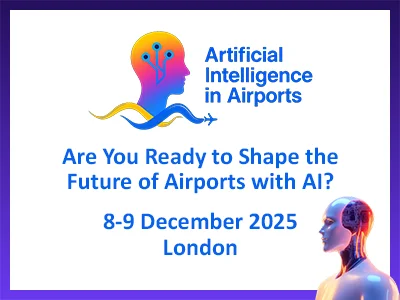Intelligent thinking
Share

Stephan Hirmer, Amadeus’ head of end-to-end passenger servicing for airport and airlines operations, considers how AI is transforming aviation.
The air transport industry is under increasing pressure to handle growing passenger volumes while maintaining high security standards and meeting the expectations of today’s travellers for a seamless experience.
With Airports Council International predicting passenger volumes will grow by 10% to reach billion this year, traditional passenger servicing methods are becoming stretched, leading to bottlenecks, delays and frustrated travellers.
This challenge is particularly acute at major transit hubs, where efficient passenger processing can mean the difference between smooth operations and system-wide delays.
And as passenger numbers continue to rise, airports must find ways to achieve operational efficiency and deliver a great passenger experience.
From streamlining airport processes to managing unexpected disruptions, AI technologies are helping the aviation industry meet these challenges.
This article examines two key AI use cases that are already delivering results: computer vision systems for passenger processing and intelligent solutions for disruption management.
These examples demonstrate how artificial intelligence can remove friction from the travel experience while helping airports and airlines to optimise their operations.
How computer vision supports smoother passenger processing
Computer vision systems use advanced machine learning algorithms and neural networks to process and analyse visual information in real time, making them ideal for busy airport environments where fast, accurate identification of passengers and assets is critical.
These AI-powered systems are particularly effective when used within biometric processing systems.
Advanced computer vision algorithms can recognise and analyse facial features with remarkable accuracy, taking into account variations in face types, poses and lighting conditions.
The technology creates what’s known as a biometric template – a unique digital signature based on an individual’s facial characteristics – which can be matched with high accuracy against images that are held for a short period of time.
The practical implementation of this technology is changing the way airports process passengers. Instead of relying on traditional identification documents, travellers can now choose to use their biometrics as an identifier throughout their journey.
This shift from physical to biometric identification not only enhances security, but also significantly reduces processing times at key touchpoints such as check-in, security and boarding. By automating otherwise manual checks, they are much more accurate as they remove potential human error.
An example of this technology in action is the Vision-Box Seamless Journey Platform. This system connects multiple stakeholders across the passenger journey, creating a single digital identity management platform.
The technology enables passengers to move through various airport checkpoints without having to repeatedly present physical documents, while maintaining high security standards through continuous biometric identification and verification.
The benefits of implementing such systems go beyond faster processing times. Airports using AI-powered biometric solutions report improved accuracy of security checks, reduced operational costs and increased passenger satisfaction.
Having more intelligent systems in place also helps airports to refine their operations and allocate resources more efficiently.
As the aviation industry continues to evolve, the integration of AI and biometric technology will become increasingly important for airports looking to maintain a competitive edge while delivering the efficient, secure and seamless experience today’s travelers demand.

Accommodating disrupted passengers with AI
Flight disruptions remain a persistent challenge in aviation, with a recent report finding that more than half of airline and airport leaders report levels of disruption above the 2019 norm.
Traditional manual approaches to managing these disruptions often result in overwhelmed staff, frustrated passengers, and significant operational inefficiencies, with re-accommodation processes sometimes taking 12 hours per affected flight.
The complexity of modern airline networks, particularly in hub-and-spoke systems, makes disruption management increasingly challenging.
When a flight is cancelled or significantly delayed, airlines must consider multiple factors simultaneously: available seats across their network, passenger priorities, connecting flights, and the ripple effects on crew scheduling and the broader operation such as airport slots and craft maintenance. Without advanced technology, this situation can quickly become overwhelming.
Artificial intelligence is emerging as a key tool in transforming how airlines handle disruption. Modern AI systems can process vast amounts of data in real-time, considering factors such as passenger status, connection requirements, and available capacity across multiple flights and partner airlines.
These systems use machine learning algorithms to evaluate thousands of possible solutions and identify optimal re-accommodation options for affected passengers.
The technology goes beyond reactive measures, incorporating predictive capabilities that can anticipate potential disruptions based on factors such as weather patterns and operational data. This enables airlines to take proactive steps, potentially offering alternative travel arrangements before passengers even leave for the airport.
The systems can also prioritise solutions based on various factors, such as ensuring business travellers with tight connections receive priority rebooking while still maintaining fair treatment for all passengers.
Air Canada’s implementation of this technology provides a clear example of the potential benefits. Prior to implementing AI-powered recovery, the airline’s disruption management was largely manual, requiring extensive co-ordination across teams and expert knowledge of its network.
The process could take anywhere from 45 minutes to several hours per flight, often resulting in congested terminals. The airline now consistently provides affected passengers with rebooking options within 30 minutes of a cancellation notice, with most travellers receiving new arrangements in just 10 minutes – a dramatic improvement from the previous average of 12 hours.
The process of creating these options is incredibly complex, but this automated system considers the airline’s complete network capacity and passenger prioritisation policies in a few moments, enabling faster and more efficient decision-making during disruptions.
Passengers are also able to choose from multiple rebooking options in case the first option isn’t suitable for them, ensuring their experience is the best it can be.
The implementation demonstrates how AI can significantly improve both operational efficiency and passenger experience during disruptions.
By automating complex decision-making processes and considering multiple variables simultaneously, these systems help airlines maintain service levels even during challenging situations, while ensuring fair and efficient re-accommodation of affected passengers.
The agents in charge of the system still have full control of it and can adapt the solutions it proposes for passengers if necessary.
The use of AI technology in aviation is more than just a technological advancement – it’s a strategic response to the industry’s evolving challenges.
As the industry continues to face growing passenger volumes and operational complexity, the strategic use of AI solutions will become increasingly important to maintain competitive advantage.
The future of aviation lies not only in overcoming these challenges, but in using technology to turn them into opportunities for improved passenger experience and operational excellence.







